One thing that adds to the list of why moving is dreadful is washing machines. Yes, sometimes people don’t want to leave their beloved appliances behind. But, you would, too, if you saw how much work it is to relocate with a washer.
However, there’s a good chance that moving a washing machine may not be so bad. And that it is only hard because of the blunders you make in the moving process.
There’s no doubt everyone makes mistakes, but some have harsher paybacks than others. For instance, forgetting to buy sugar at the stores is small-fry compared to the mistakes that could wreck high-cost laundry equipment.
Luckily, this guide tables every useful detail about moving a washing machine safely. You’ll be safer if you keep reading.
Where Are You Moving?
There’s always a need to move houses at least once in a lifetime. You might have to move internationally or relocate within your country for a job opportunity, school necessity, or to reconnect family ties.
But moving comes with a fair share of unpleasantries, depending on how far you need to go. You can’t expect it to be rosy with all the time and effort it involves.
At first, moving may look like you control and spin all the factors until you find a washing machine in the mix. It seems like nothing really but, think it over before moving with it. And if you are making a long-distance move or relocating abroad, it’s not practical, sometimes, to bring the washer with you.
There you go, worrying about living in a foreign place without a washer. Mate, if moving with the washer proves to be daunting and costly, it’s probably not worth it.
You should consider leaving it to friends or neighbours before moving. Or, you can sell it and use the cash to move or to buy another. Do you want to know why? Here are the pros and cons of bringing the washing machine during the move.
Pros
- Selling it before relocating or leaving it behind can help you cut a great deal of moving expenses. The reason is, washers are bulky and tricky to move.
- Do you want to upgrade your washer? This is the best opportunity to sell and make a little money for your next top-tier laundry appliance.
- You can increase your old home’s sale value if you leave and sell the washing machine to the new owner.
- Selling isn’t hard anymore, with all these online markets and apps for selling equipment.
- Buying new appliances might not be what you want when you move into your new home. You can move with it to avoid the expenses of purchasing another washer. However, it is crucial to consider the shipment cost of running away from the expenditure.
Cons
- Long-distance relocations are money-minting. You should consider leaving it behind if you are moving long-distance. The reason is; the cost of moving might be higher than the cost of buying a new one. For instance, shipping by air or road needs a big budget.
- It’s time-wasting. No doubt, some means like water transport are cheaper than other means when moving bulky loads. But sea shipments can take ages to reach your new home. Are you willing to wait for months? And you’ll be lucky if it will end up in the same state as when you left with it.
- Your washer may not fit into your new place. It might force you to renovate your new house to accommodate the design of the washer.
To And From A Place With Stairs
Moving into a brand-new house is exciting and fun until – that is – you encounter the staircase. Laundry machines are huge and cumbersome, so there’s nothing good about carrying them up or down a flight of stairs. For instance:
Difficulty In Maneuvering
Massive equipment and tight stairs are not the best of friends. Therefore, if there’s no other way than the tight and complicated stairs, you will have a hard time finding the ideal position of getting the machine up or down.
Damage To The Item
If you are moving through compact stairs, you will most likely bump into the wall or scratch the washing machine on the rails. Such impacts can damage the fragile edges of your appliance.
Injuries
Walking with the washer up and down the stairs may make the body twist unnaturally. You might end up falling, straining, and spraining your back, neck, hand, or shoulders. Such injuries can lead to long-term catastrophes.
However, you should not lose hope as there are ways to beat the hassle around stairs when moving a washing machine. You can use:
1. More Manpower
No doubt, you are a hulk or maybe a chronic DIYer. But that shouldn’t prevent you from getting an extra pair of hands to help move your appliance. You know, having someone to help can come through for you in case it gets too hard, or you get an injury mid-way.
Plus, almost every hack you’ll use to get the washer up or down the stairs requires another pair of hands.
2. Ropes
To prevent your appliance from shifting during transit, you can tie it down with a rope. You can secure it onto a dolly. You can also use it to keep the door shut for transit.
3. Dolly
Carrying the home appliance can expose you to extensive bodily harm. However, that will not be the case if you get yourself a dolly to help – quickly and safely. Don’t worry if you don’t know how to get it.
You can buy it – that way, you can use it when the opportunity presents itself. If you already own one, you can earn some extra cash by renting it to other people. Alternatively, you can rent it from any moving company within your town.
4. Boards
Moving involves a lot of pulling that damages the floor. You can protect the floor by laying down boards to limit the scraping and scratching.
5. Blankets
You are going to have to protect the appliance against accidental bangs and scratches with thick blankets. Asking how? Wrap the blankets around the machine before you transport it.
Ensure that you leave no part of the appliance bare. After you cover the washer’s surface, use ropes or straps to secure it.
Moving Abroad
Relocating abroad opens up new beginnings and tidings. While it should be something to be enthusiastic about, the challenges involved can dampen expectations.
The reason is that dragging your appliances across other parts of the world demands a lot of time and effort. These demands can force you to leave your machine in your old place. Below are some challenges you may face when moving your washing machine abroad.
1. High Shipping Fees
Taxes and custom fees imposed on appliances aren’t a walk in the park. The reason is, they charge the fees based on the weight of your machine. So, the heavier the load, the more fees you pay. The fees might even tower higher than the cost of buying another machine.
2. Difference In Voltage And Frequency
Different countries have different standards for electrical power. And manufacturers build gadgets per set standards. It means that if you move your gadget to a country with much higher or lower standards than yours, your item might fail to work over there. Or worse yet, you can cause damage to your other devices or start fires.
3. Difference In The Electric Plugs
Unfortunately, your plug might not be the standard one for your target country. It is surprising, right? Well, it is time you knew that countries differ in the type of plugs they recommend. Some advocate the one with two round tips, while others accept plugs with the triple straight ends.
You may think you can buy adapters and make it through, avoid considering this because it is not the safest option. You have to find another appliance for your new home.
4. Damage To The Laundry Machine
Moving such a mighty load across the world exposes it to a lot of shifting, shaking, and vibrations. The motions harm the interior of the appliances. It might break along the way from the vigorous movement.
5. It Might Not Befit The New House Design
Building designs differ, with each country adopting various construction techniques. For instance, you might not find the in-built system for your appliance is not fit for your new home. It might force you to buy brand-new equipment or renovate the house.
What Do You Need?
Below are some things you might need to prepare the machine for movement.
The Washer Shipping Bolts
Keeping the large and heavy laundry gadget from jostling during the move is not so easy. For this reason, you will require transit bolts – metal rods that are fit into the washer to lock the drum and immobilize it during transit.
The bolts are essential because the shaking during hauling can damage the machine. The costs of the repair might be more than acquiring a new laundry machine.
Dolly
Rent out a two-wheel dolly to move your machine. The good thing about a dolly is that it has blades that can support the washer. Once you strap the appliance to the dolly, you and your helper can go on and tilt the equipment back to balance it on the dolly. There you go – another brilliant idea to wheel your laundry machine up or down the stairs.
Furniture Covers or Blankets
You can use blankets to protect your washer’s surface against scratches whilst moving. You can use a furniture cover as a shock absorber, too.
Packing Tape
The cords and the valves on the washer need to be tucked up as well, and packing tapes can do that for you. All you need is to have tapes around the parts. Apart from that, you can use the tape to ensure that the blanket covers the machine entirely.
User Manual
The long time you had around your laundry machine might make you think you know every inch around it. It might not be the case, however, because manufacturers know things users don’t.
For this reason, you must keep the user’s manual around for reference. Like, don’t you need some insight into how to install the transit bolts? You can find that information and much more in the manual.
Another Set Of Hands
Do you want to move your dear laundry machine between homes safely? If yes, getting friends, family, or movers to help is the way to go. Bet the people you’ll go to first are friends and family, right?
Well, in case you don’t have your dear ones to help, professional movers are a great option. They are not only affordable but also ensure that you can cast your burdens on them while you relax and watch. After all, they are out there to give their best and build their reputation.
5 Steps To Move A Washing Machine
If you are moving a washing machine on your own, be ready for a bumpy ride. However, keep in mind that whatever you do, you must ensure that it does not harm your washer. The reason is replacements and repairs cost a fortune. So, how do you move your washing machine?
1. Clean Up

This step is obvious. Well, before you think about preparing it for transport, count the pairs of socks you have. You might realise that one or two pieces of socks are missing its pair.
If you inspect your machine closely, you might find the missing sock inside the drum. All the more reason to clean your machine before you haul it.
Begin by emptying the drum and running warm water inside it. It’ll help get rid of the residue from the cleaning detergents and drain lines on the sides. After washing in, wash the top of the machine and around it, too.
It is equally important to dry out your appliance. You can use a dry rag to wipe the water off the drum or the surface. And if you have time, you can leave the washer’s door open for at least a day for it to dry.
2. Disconnect
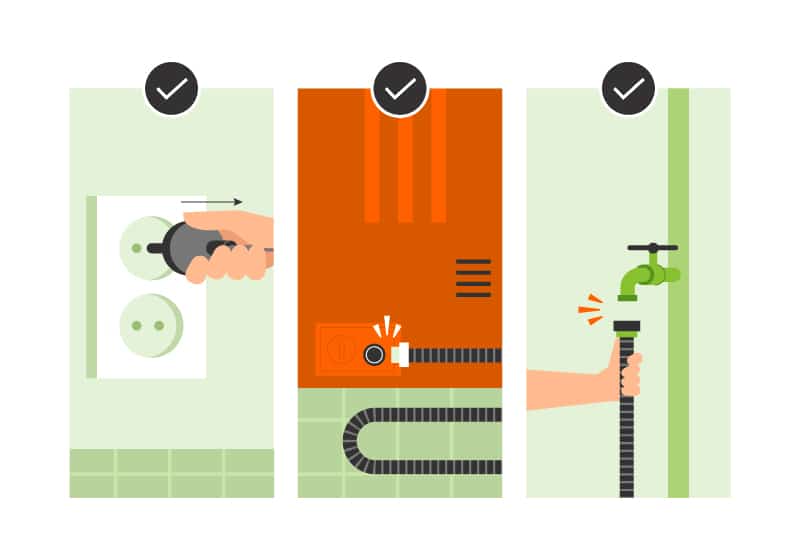
Washers work because they connect to a power supply. You might harm yourself if you handle it without minding the electricity. Start by cutting off the primary power supply to prevent electric shocks.
After cutting the power supply, get down and disengage the plug from the socket. Apart from electricity, it is essential to disconnect it from a water supply.
To do so, turn off the valves behind the machine. Beware of the hosepipe, too. Since they might contain water, drain both hoses from the cold and hot sides.
You can secure these parts (power cord, hose, and valve) by wrapping packing tape around the parts. Ensure that you secure them with tape to the bracket at the back of the equipment.
3. Use Transit Bolts
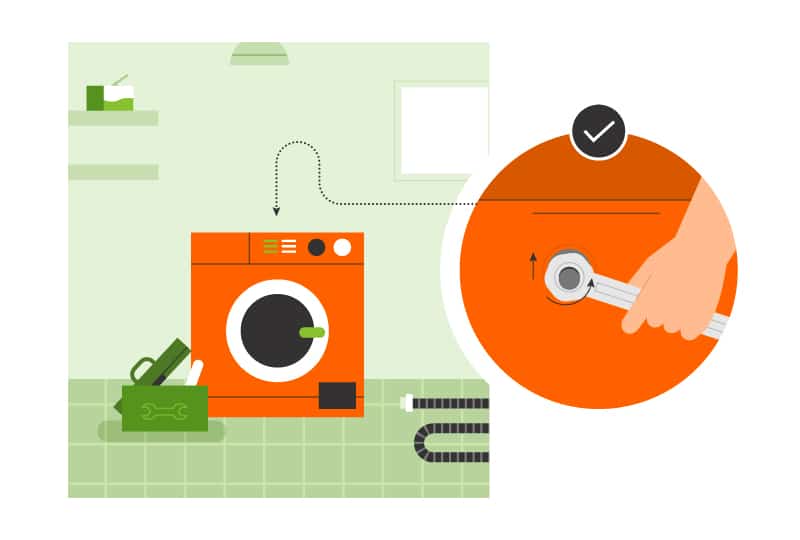
Hauling involves lots of shaking and vibrations that might damage the washer. Therefore, it is crucial to immobilize every part of the appliance and keep them in a stable position.
To do so, you need to install the moving bolts in the laundry machine. They’ll help to lock the drum in place and keep it still during the entire process.
Installing can be a new concept to you. For this reason, seek knowledgeable hands to help you. If no help’s forthcoming, you can turn to the user manual for step-by-step guidance.
It should instruct you to insert the moving bolts into the opening on the sides of the washer. Once they are in the openings, turn them until you feel that the drum is immobile and locked in place. If it is difficult, you are free to contact any home appliance store around you for help.
4. Move It!
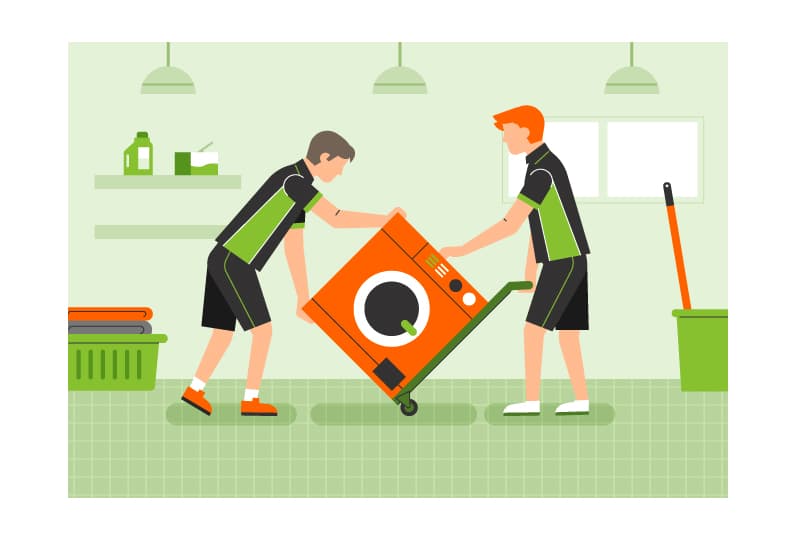
Now that everything is in place, brace yourself for the last but vital step in this journey. Any blunder during this stage can harm you and the precious equipment. Therefore, turn to friends, family, or movers for help if you are afraid to do it.
Protect your appliance before you move it. Luckily, you can use readily available blankets or furniture covers. They are vital because they protect your gadget from bumps and scratches that may occur.
And, if you trust your moves, secure the cover with ropes and tapes and lift it onto a trolley or a dolly. If it is steady and secure, go ahead and wheel it out of the home.
5. Unload It With Reverse Steps
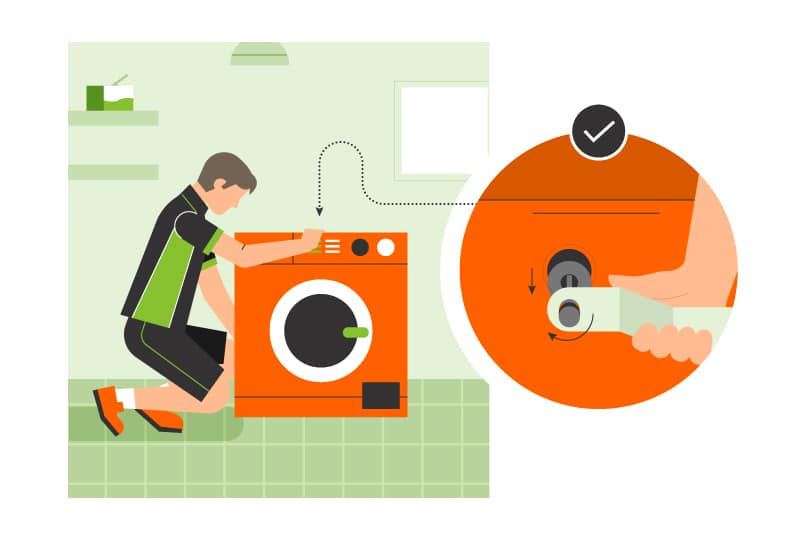
Congratulations on bringing your beloved washer home with you. There’s no need to worry about the state of your load since you were keen on not dropping it. Now that this staple appliance is home, you can remove the covers. Once again, bring it to use by taking reverse steps.
Now that the washer is in the laundry room, you can uninstall the transit bolts and set it free. Go ahead and connect your machine to the water supply by unwrapping the valves and the hose pipes at the back.
You can also plug it into the power supply and do your laundry. You must be sweating and dusty!
Do You Need Help?
You need all the help you can get during the moving process. Although you can handle it on your own, doing it with a buddy, kin, or professional movers sounds like a better deal.
You won’t have to bear the burden alone. You can also count on a little chit-chat here and there. Moving a washing machine can be daunting without someone’s company!

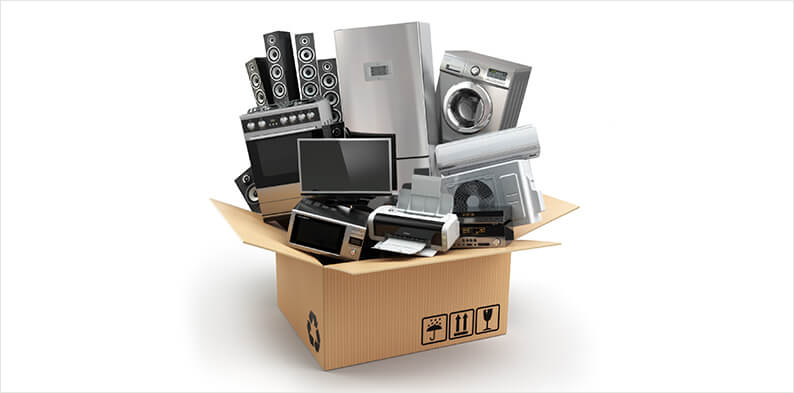




0 comment